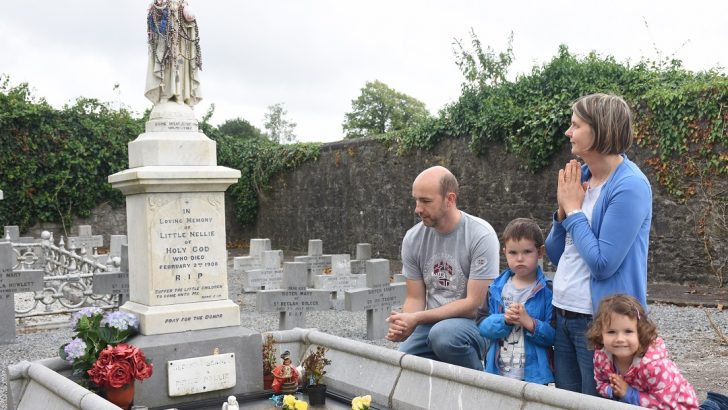Little Nellie – Special Feature
Chai Brady hears about a community’s intense desire for Little Nellie’s sainthood
Even though she died over 100 years ago Ellen Organ, best known as Little Nellie of Holy God, continues to inspire devotion among a significant number of people in both Ireland and abroad, with a growing number calling for her to be made a saint.
Much of this comes from Cork, where Little Nellie spent a lot of her short life which was marked by severe suffering. Despite having a crooked spine and several other medical conditions she later developed, she expressed a great faith and understanding of the Eucharist. Nellie is often credited with being an influential factor in Pope Pius X’s decision to lower the age children could receive Communion.
Little Nellie was born on August 24, 1903 in a military barracks in Waterford. When her father, who was a soldier, was transferred to Spike Island the family moved with him in 1905. Nellie lost her mother Mary to TB in 1907, and her father put the children into care as he was unable to look after them – they were all under the age of nine at the time.
Little Nellie and her sister Mary were sent to the Good Shepherd Sisters in Sunday’s Well, on the mainland, where she spent most of her time in the infirmary. Before this she was examined at the Sisters of Mercy hospital, where she was diagnosed with whooping cough. This highly contagious bacterial disease that causes large bouts of coughing and choking – making it very hard to breathe – had a much higher mortality rate in the 1900s.
A researcher and tour guide dedicated to Little Nellie’s cause and the promotion of her life and holiness, John Flynn of Cobh Town Tours, told The Irish Catholic: “When she was suffering she always said this is nothing compared to what Jesus suffered on the cross, so she had a spiritual awareness from the moment she was born.
Holy hour
“She longed to get her Holy Communion, kept on crying, kept on saying she wanted to get it, in one of her communications she said that Jesus had told her he was going to fly her to heaven on Holy God’s day on the holy hour, and she actually did die on a Sunday at 4pm, so she predicted that.”
The Good Shepherd Sisters, in light of her desire for Communion and profound knowledge of the Faith, asked that her case be investigated. Then Bishop of Cork and Ross, Alphonsus O’Callaghan, allowed this to happen after she was interviewed.
It is believed Bishop O’Callaghan visited her on several occasions, which Bishop Emeritus John Buckley of Cork and Ross reiterated when he said to this paper: “My predecessor, Bishop O’Callaghan, he was a Dominican and he visited her shortly before she died regarding Holy Communion which she had been requesting for some time, and he asked her a specific question, he asked her who are you receiving? She said, ‘I’m receiving Holy God on my tongue and he will go down into my heart and he will make me very holy’.”
Little Nellie is associated with having the miraculous ability to know when someone had received Communion. It is said that the nuns would go to Mass in the morning, out of site of Little Nellie’s room, and some would receive the Eucharist and others wouldn’t. Apparently, the young girl was able to tell each time who had and who hadn’t – one of the supernatural signs people say is an example of her holiness.
The four-year old also called the chapel on the convent grounds ‘the Holy House of God’ and referred to God as ‘Holy God’. When she first heard about the Passion of Christ, it said that she burst into tears. Little Nellie also claimed to have visions, one of which she saw Christ as a child and the Virgin Mary and on several occasions said she saw the Infant of Prague dancing for her.
She said, ‘I’m receiving Holy God on my tongue and he will go down into my heart and he will make me very holy’”
Her suffering intensified as she neared the end of her life, Mr Flynn said: “She suffered from a spinal disease but her big one would have been she had caries of the jaw, which meant that it was very swollen, infected, had to be cleaned every day. Just before she died a little piece of her jaw actually fell away.”
Her caries, which is the decay and crumbling of tooth or bone, emitted an intense odour and caused her difficulty eating.
According to Princesses of the Kingdom, Jacinta Marto & Nellie Organ, by Leo Madigan, a nurse would syringe disinfectant into the wound, which “hurt considerably”.
It reads: “This, although it hurt considerably, was nevertheless not once resisted by the child after her Confirmation. When the nurse took out the syringe, Nellie took out her crucifix. Giving her intelligent consent to this pain, which clearly God had laid upon her, she thought of the Great Atonement. When the pain was greatest she used to lie motionless in bed, her arms crossed on her breast, her little fingers folded round her crucifix.”
It also states that upon receiving Communion, the odour from her caries ceased.
It is said that a priest, a nurse and two other witnesses said her corpse was intact, her hands flexible and her hair had grown a few inches”
According to her death certificate, it was ‘chronic’ TB that she died from in the end on February 2, 1908. She received First Communion on December 6, 1907 and continued to do so frequently by being carried down to the chapel until her death aged four years, five months and eight days old.
Little Nellie was buried in St Joseph’s Cemetery in Cork. Her remains were exhumed a year later after the Good Shepherd Sisters were given permission to move her body back to the convent. It is said that a priest, a nurse and two other witnesses said her corpse was intact, her hands flexible and her hair had grown a few inches.
The dress, wreath and veil of First Holy Communion, in which she requested to be buried, were said to be intact and her silver medal of the Children of Mary bright as if it had just been polished.
After this many people began visiting her grave from Ireland and abroad, some to satisfy their devotion and others to ask for cures.
Experience
Mr Flynn said that he had a profound experience relating to Little Nellie that shaped the course of his life, and is the reason he aspires to be an “ambassador” for her and her cause for sainthood now.
“I wasn’t working in history, I wasn’t working in tours, I started doing Spike Island. I passed her house one day, I would have known about a little girl called Little Nellie, nobody knew about her and as I passed the corner, I felt I couldn’t walk anymore,” he said.
“I felt I went deaf for about 10 seconds, I couldn’t hear the bushes or the trees or the water and I didn’t see anything but I got a very powerful peaceful feeling and the Virgin Mary flashed into my head quickly followed by a photograph image of Little Nellie and I could hear again and I got a fright and from then on I said I must do research into this little girl, and that’s how it all started.”
There was several occasions when he felt like giving up, and was struggling to conduct research on Little Nellie but each time he feels something happened to put him back on track.
He said: “For example I was in Ballincollig in Cork on Christmas Eve and I just picked up a paper that’s only out every year for Christmas, and I opened it on a page and there was a big write-up about Little Nellie.”
Originally conducting tours on Spike Island, Mr Flynn said he would like to bring more information about her further afield and join with others interested in pushing her cause for sainthood to be opened.
Organising tours of Little Nellie’s grave every few months on request, he said interest in growing, saying last time he went 50 people attended. He adds: “With all the people I’ve met, they’d like for her to be acknowledged better than what it is at the moment.”


 Chai Brady
Chai Brady Pawel, Justyna, Antoni (4) and Hanna (2) Slodzinka, originally
from Poland, pray at Little Nellie’s grave. Photo: Chai Brady
Pawel, Justyna, Antoni (4) and Hanna (2) Slodzinka, originally
from Poland, pray at Little Nellie’s grave. Photo: Chai Brady